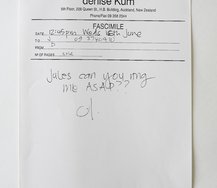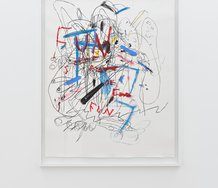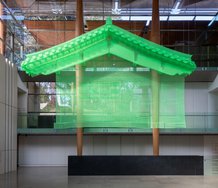John Hurrell – 30 November, 2025
There is a lot to think about while contemplating the many different divergent threads of American contemporary art history—some sequential; others not. This is aided by the extremely informative wall labels written expertly by a group of participating curators. These collectively make up the excellent accompanying illustrated hardcover publication.
Pop to Present: American Art from the Virginia Museum of Fine Art
Curated by Alexis Assam, Regina Perry, Sarah Powers, and Kenneth Brummel
8 November 2025 - 15 March 2026
Put together by three curators from Virginia, in partnership with another from Auckland, Pop to Present is a super-duper survey of North American art that emerged after the Second World War. Fifty-two vibrant works from the Sydney and Frances Lewis Collection in particular, showcase an unusually wide range of practitioners, ensuring many diverse communities and styles are represented, organized with ten linked-up, carefully labelled rooms.
There is a lot to think about while contemplating the many different divergent threads of American contemporary art history-some sequential; others not. This is aided by the extremely informative wall labels written expertly by a group of participating curators. These collectively make up the excellent accompanying illustrated hardcover publication.
The show’s aim of cultural and political inclusiveness might suggest that the resulting quality is doomed to be suspect in its efforts to please, but this is not the case. There is no sense of compromise even though there is a mood of ‘something for everyone’—courtesy of well-established art historical contingencies. The four curators have done an excellent job, avoiding predictability: for there are many unanticipated surprises within the sorts of chronologically defined image picked. Even despite the absence of major influencers like say Duchamp or Man Ray, any visit is still always a memorable treat-helped by the mentioned useful catalogue.
The catalogue cover features a two-canvased work by Rosalyn Drexler based on photos of convicted criminals hiding their faces from newspaper photographers as they leave the court. Two women are on the left; two men are on the right. The highly ambiguous image on the right (the lefthand head at the back) has a ring on his finger that could be a blue-pupiled eye, and a thumb that could be an open mouth in profile.
For me personally, the obvious highlight of the show is the huge Clyfford Still painting in the first room that extends from floor to ceiling with its butted jagged organic forms. I have returned to it over and over, utterly fascinated by its strange pale shapes, ascending cliff-like prickly pitted textures, pointy edges, and aggressive viewer-body-targeted tactility.
Jack Whitten’s scraped off outer layer of black paint to reveal glowing colours underneath (like sgraffito) is a wonderful surprise, incorporating pure straight or circular geometric forms alongside undulating organic ones. It brings back childhood memories at intermedate school, an ageless technique that never loses its appeal.
The circular stained loops and hovering stacked dark splotches placed by Helen Frankenthaler on another canvas also have a vertical dynamic, along with a primal power and shuffling oily instability, but as a sample of her abstract practice the ‘landscape’ example here over-all seems oddly little, uncharacteristically so, and ‘domestic’. As does the diminutive Rothko that seems like a very small explorative ‘test-run.’
Sam Gilliam’s shaped and heavily textured painting however I also found disappointing, due to its constantly pervasive surface textures. I expected more planar contrasts and some incorporated much-flatter smooth shapes, a mistake on my part, having looked at too few photographic reproductions of his unusual practice. In his work, light-trapping surface textures are always dominant.
Nevertheless to see exhibits like those of Donald Judd’s boxlike aluminum sculptures, or a wall-based folded felt work by Robert Morris, here in Auckland is an exciting event. Morris creates my favourite contribution, closely followed by Judd and then Gary Simmons’ graphic open-mouthed (multi-interpretative) ‘cartoon’, Screaming into the Ether, 2020.
The two large elegant Judd ‘minimalist’ modules are carefully spaced apart on the wall according to detailed artist instructions. The interaction between cast shadows and quite thick diagonally-angled planar insertions is a dramatic but nuanced presentation. And although I am not usually drawn to photorealism there is considerable wit in Robert Cottingham’s painting of an unilluminated neon sign saying ‘optic’ above a cinema frontage. In broad daylight it celebrates the physical mechanics of the gaze, movies as an invention, and the major role of outdoor sunlight.
Over the years I have looked at a ton of touring international shows in New Zealand, ever since I was an art student in the early nineteen seventies, and this American exhibition is easily the best ever. The high quality is consistently maintained throughout. For regular art-lovers, only commonly acknowledged nitwits would miss it. It is a stunning art-viewing opportunity because of its wide range and long four month schedule, one which effortlessly encourages many enthusiastic repeat visits.
I write this as a global citizen deeply concerned about the dopey Trump presidency, yet to boycott the show would be nuts. I love American music, literature and art, and the culture’s propensity for democratic debate, and this is a fantastic line up of great art.
John Hurrell

 Two Rooms presents a program of residencies and projects
Two Rooms presents a program of residencies and projects Advertising in this column
Advertising in this column



This Discussion has 0 comments.
Comment
Participate
Register to Participate.
Sign in
Sign in to an existing account.